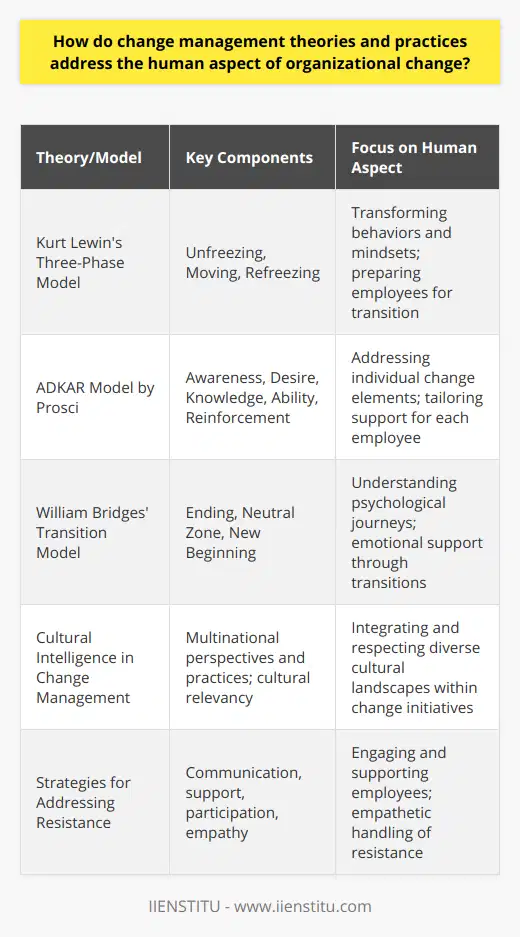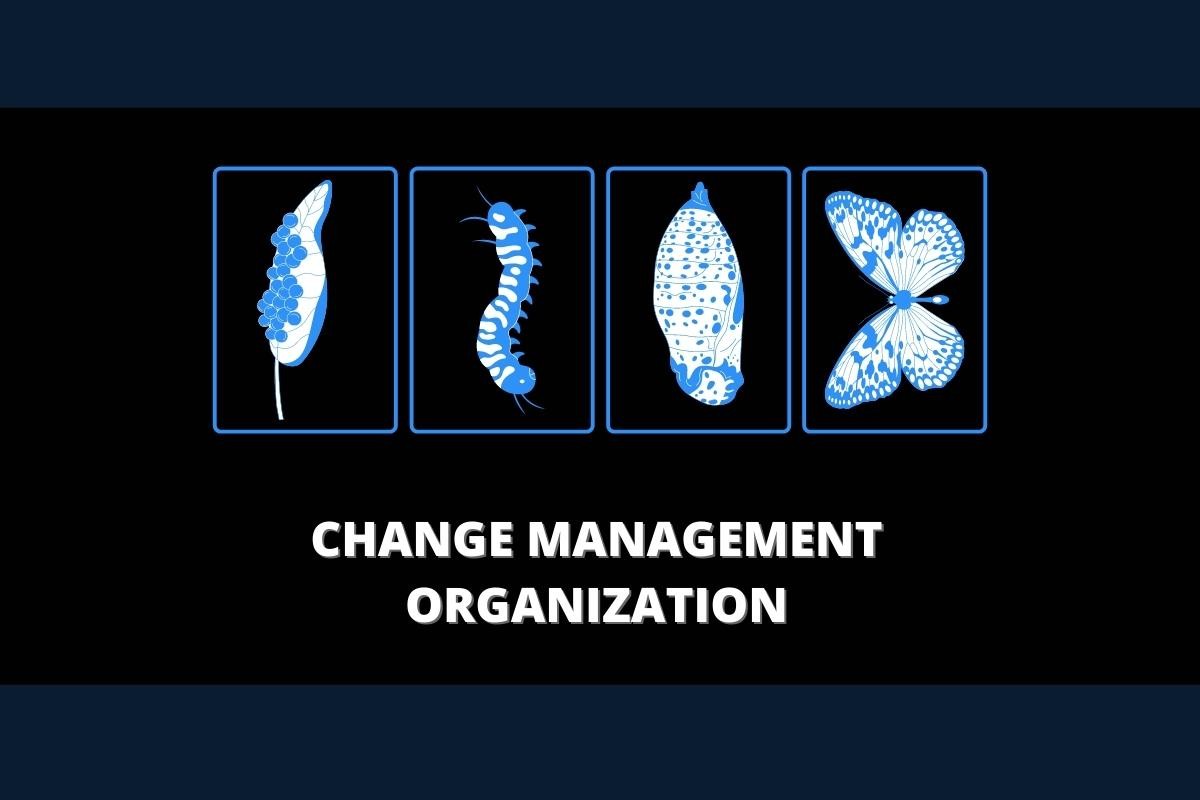
There are a number of specific roles that will be required to make the appropriate changes within an organization, including both those who exert their influence on top management as well as those who report directly to them. Being aware of each one's role is crucial for any business which wishes to ensure their long-term success by remaining adaptable and flexible enough to handle whatever challenges the future may bring.
Understanding Change Management Roles
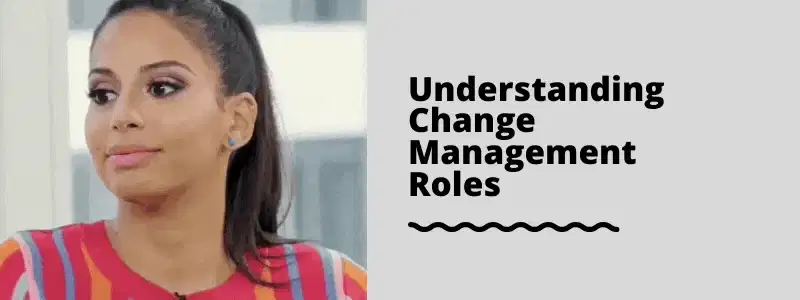
Top Managers: The top managers of an organization are those who sit on its board of directors and whose primary concern is that the company remains both profitable and sustainable in terms of maintaining (or increasing) market share, among other things. This means that their role within a change management process will be to provide the resources and support needed for those who are charged with making decisions on a lower level by encouraging them to think outside of the box where possible, as well as weighing in with their own input when asked.
Middle Managers: The second tier of management within any organization is responsible for its day-to-day activities, which primarily involve making sure that the company is operating smoothly and according to plan. As such, their role within this process is one of facilitator - they are there to offer advice on how best to implement new changes based on what has worked in the past, while also remaining aware of any difficulties that might arise during the process.
Department Leaders: The people who hold the most hands-on roles within this instance are typically department leaders, whose primary responsibility is to oversee the implementation of whatever changes have been decided upon in their specific area or field. Having said that, they may also be given additional tasks during this process which involve overseeing activity within other departments.
Employees: The employees of a company are the ones who will be most directly impacted by any changes which are made, as they are the ones who will be responsible for carrying them out. It's therefore essential that those who are leading the charge on implementing new changes take into account the various needs and concerns of those who will be affected, in order to minimize any potential resistance.
No matter how well-planned a change management process may be, there is always the potential for things to go wrong. By knowing and understanding the various roles which are involved, however, companies can at least minimize the chances of this happening and ensure that everyone is working towards the same goal.
What is Change Management and Why Do We Need It?
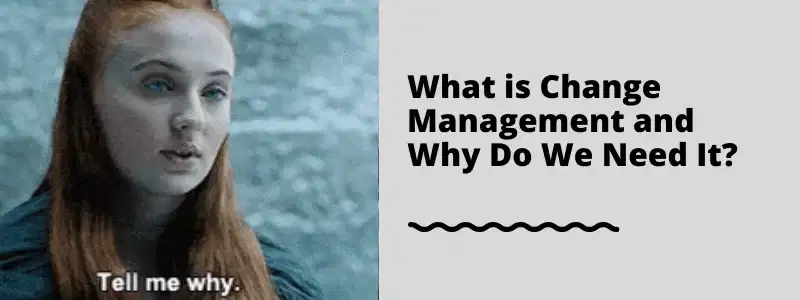
What is change management and why do we need it? As the name suggests, change management is all about managing change. It's a process that helps your team collaborate and make decisions about how changes will be implemented. It also ensures their success by providing them with guidance on what needs to happen before, during or afterwards so as not to affect other aspects in a negative manner.
There are many reasons why you might need to implement change management in your workplace. Perhaps you're introducing a new software system, or maybe you're restructuring the company. Whatever the reason, change can be unpredictable and risky, which is why change management is so important. It helps to minimize the risks and makes sure that everyone understands what's happening and why.
Although everyone in an organization can contribute to change management, it's usually undertaken by the people who are leading the project. They're responsible for managing any possible risks that could be involved with implementing it. Change management is about communication and collaboration among your team, so it's important that you set up a system that allows everyone to feel included and involved.
Why Change Management Matters?
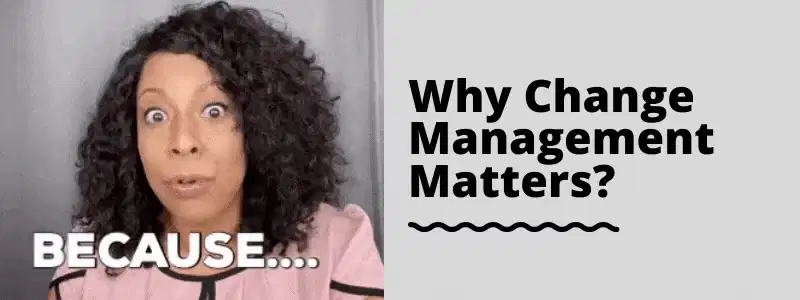
A good indicator of why change management matters so much is the survey conducted by the Project Management Institute (PMI)® in 2012, which revealed that 52% of all projects fail due to ineffective Planning or lack of knowledge about requirements before starting out.. Now more than ever, organizations are relying on technology to get things done quickly but there are many risks involved with this. For example, a solution may have been developed for a problem you don't actually have, or it may not be suitable to the culture within your company. If your employees don't understand why these changes are being made, they won't be able to provide feedback that could help improve the situation.
What is Change Management?

Change management involves different activities and tasks which focus on bringing about planned change in the workplace. Change management helps organizations introduce new technology systems or processes smoothly by coordinating with everyone involved in making it successful
What Does Change Management Do?
Change management ensures everyone understands what's happening and why
It helps minimize risks by providing guidance on what needs to before, during or after the implementation of changes
It helps everyone understand that the change is for a good reason
A structured approach to change management can help minimize risks. Change management is essential when introducing any kind of new technology system or process which has the potential to affect people in your organization. While it's important to always be improving and developing, this doesn't have to mean completely overhauling everything you already have in place.
What Does a Typical Change Management Process Look Like?
Having a set change management process will make sure that anyone involved understands what they need to do and by when at each stage of the project. It also makes it easier for staff members who aren't directly involved in the project to see how they can contribute from an outsider perspective.
When to Use Change Management?

Change management is used when introducing any kind of new technology system or process which has the potential to affect people in your organization.
Change Management helps manage risks by minimizing impacts on people, budgets and timelines. A structured approach to change management can help minimize risks. With fewer risks involved, you're more likely to see a successful result that everyone in your team benefits from.
There are many reasons why you might need to implement change management in your workplace. Although everyone in an organization can contribute to change management, it's usually undertaken by the people who are leading the project. They're responsible for managing any possible risks that could be involved with implementing it. Change management is about communication and collaboration among your team, so it's important that you set up a system that allows everyone to feel included and involved.
Change management can be applied across different industries. For example, if you work in the technology industry, there are likely to be changes made regularly as new systems are being developed or integrated with existing ones. But change management isn't just limited to the technology industry - it could also affect any field where introducing change is common practice (e.g., retail, financial services).
What does planned change look like? When you're planning for change at work it means thinking through every detail of the process carefully before putting anything into action.. This includes considering what problems might arise during or after the change is made, and having a plan in place to deal with them.
The goal of change management is to make sure that everyone understands why changes are being made, what's going to happen, and how it will affect them. Employees need to be on board with changes if they're going to be successfully implemented. If there's resistance among your team to change, it can lead to problems such as decreased productivity and even staff turnover. That's why it's important to foster a positive attitude toward change within.
Change management is an essential part of the process that helps your team collaborate and make decisions about how changes will be implemented. It also ensures their success by providing them with guidance on what needs to happen before, during or afterwards so as not affect other aspects in a negative manner. By setting up a change management process, you're ensuring that everyone is on the same page and that any risks associated with change are minimized. This will lead to a smoother transition and fewer problems down the road.
Why Does Change Management Matter to The Organization?
There are many reasons why change management matters to the organization. One of the most important is that change management can help make sure that the organization is able to quickly and effectively respond to any changes that may occur. This can help ensure that the organization is able to continue running smoothly and avoid any major disruptions.
Another important reason why change management matters is that it can help ensure that changes are made in a controlled and coordinated manner. This can help minimize the potential for any negative impacts that the changes may have on the organization. Additionally, it can also help make sure that everyone in the organization is aware of and understands the changes that are taking place.
Overall, change management is an essential part of any organization and it plays a major role in how well the organization is able to handle any changes that may take place. Without it, the organization would be put at a big disadvantage and could end up facing some very serious problems if anything were to happen.
Overall, change management matters because it can be a powerful tool for helping an organization deal with and respond to changes. It can help make sure that negative impacts are minimized and everyone within the organization knows about and understands what's going on. If you want your business or other organization to not only survive but thrive in today's ever-changing environment then you'll want to use all of the tools available - including change management!
The Four Stages Of Organizational Change And How They Impact Employees
Professional career fields are known for their inherent lack of stability.
The transitions in job titles and roles can cause much commotion in employees who may experience differing reactions when faced with change or unexpected events. The typically four-stage process of organizational change is well documented; however, there is no rule that says all employees will respond to change in the same way, nor will they necessarily follow the typical path. Some people face challenges head on while others try to avoid them entirely.
But what you might not know is how different stages affect an individual's life at work - something which requires careful consideration before making any changes. Here we take a look at what goes through someone's mind when they find themselves transitioning into new roles whether by accepting a promotion or being laid off.
Stage 1
"Denial" is when a person either does not believe what's happening or tries to persuade themselves that it won’t happen. It's also the stage where employees are most likely to say things have always been this way, so why change, according to Marcie Pitt-Catsouphes of Boston College in Massachusetts who specializes in Human Resources and work/life issues . If you're stuck here, be aware that although it might take time for people to come round to new ideas and concepts, your employers will ultimately expect you to get with the times.
Stage 2
"Anger" is when someone moves from denial into anger about is happening around them. This anger can range anywhere from annoyance at being confronted with the truth all the way through rage against those responsible for denying you access to opportunities in your previous role as well as blaming others who may be at fault too. This usually follows once people feel their options have been narrowed down into one extreme position such as accepting an offer (or not).
If you find yourself struggling with anger, try and take some time out to process what's going on. Talk to friends or family, journal or do something that allows you to work through your feelings. Don't bottle them up - it will only make things worse.
Stage 3:
"Bargaining" is when people start to look for ways to make the change more palatable. They might agree to take on new roles or responsibilities that they are truly not qualified for. This stage is where people start to look at their options and think about what's best for them in the short-term.Of course, if you're being forced into a role you didn't ask for it may feel like your career prospects have been severely diminished - especially if you've had to give up something else as part of the deal. That's
why this is one of the trickiest stages - because there might be some tough choices ahead of you which will determine how rewarding this transition ends up being.
Stage 4:
"Depression" is when the reality of what is happening starts to become clear and can lead into feelings that are close to despair. Many people experience this stage as a loss of control and can feel like they are no longer in the driver's seat when it comes to their careers. This is often accompanied by a sense of isolation and feelings of not being good enough.
This can be an extremely tough time for employees, but it's important to remember that it's a natural part of the process. It's also a sign that you're ready to start moving on.
As you can see, facing change is never easy - regardless of which stage you might find yourself in. But by understanding how these stages work, you can better prepare yourself for what lies ahead and make the most of any opportunities that come your way.
How to Manage Resistance During Change?
With change comes resistance. How do you manage to overcome it? You see, there are a few things we can do when faced with challenging circumstances and having the odds stacked up against us- but that doesn't mean give up! We'll take these suggestions one by one in order from easiest (or most convenient) first; this way even if some don’t work for your situation or person specifically then maybe another will still come along soon enough:
1) Keep at it
If people say they're not interested now just remember how many times before they were “unteachable." They might need more evidence or time to understand the benefits of the change. Be sure to communicate effectively and often.
2) Ask for help
If you feel like others are unwilling to change, don’t try and force it. Instead, ask them what they need from you in order to be ready. By giving them a chance to participate in the change process by offering the opportunity to share their feelings and opinions about the changes or choices that will be made they may also gain a sense of empowerment over the situation.
3) Fight FOMO
Fear Of Missing Out can cause resistance too! Sometimes potential stakeholders want to join but simply feel unprepared or not up-to-speed on certain aspects of your initiative; these aren’t necessarily people who don't WANT TO CHANGE . In fact, they might even have some great ideas/points to contribute if they're just given a chance. Address their concerns and make sure everyone is on the same page by providing updates, training, or other resources as needed.
4) Celebrate success
Even when things get tough, it's important to celebrate successes along the way! This will help people stay motivated and invested in the change process. Plus, it just feels good to acknowledge accomplishments big and small.
5) Avoid power struggles
Change can be difficult for everyone involved, but by using these tips you can help to manage resistance and create a more successful change process.
If people say they're not interested now just remember how many times before they were “unteachable." They might need more evidence or time to understand the benefits of the change. Be sure to communicate effectively and often.
By giving them a chance to participate in the change process by offering the opportunity to share their feelings and opinions about the changes or choices that will be made they may also gain a sense of empowerment over the situation.
Fear Of Missing Out can cause resistance too! Sometimes potential stakeholders want to join but simply feel unprepared or not up-to-speed on certain aspects of your initiative; these aren’t necessarily people who don't WANT TO CHANGE . In fact, they might even have some great ideas/points to contribute if they're just given a chance. Address their concerns and make sure everyone is on the same page by providing updates, training, or other resources as needed.
Even when things get tough, it's important to celebrate successes along the way! This will help people stay motivated and invested in the change process. Plus, it just feels good to acknowledge accomplishments big and small.
Finally, try to avoid getting wrapped up in power struggles with those who are resistant to change. It's important remember that there are many ways to achieve the same goal- so find a common ground and work together towards the ultimate vision. With time and patience, resistance can often be reduced or even eliminated.
Change Management Best Practices That You Can Implement in Your Organization Today
There is a famous saying: "When it rains, it pours."
In a time of change, this couldn't be more true. When the process begins to move forward, there may be new information that comes up that changes how people should react. In order to keep everyone on their feet and ready for action - you need a system in place! The following are some best practices for managing change within your organization. However, before we get started - let's define what "change management" actually means.
Change management is the art of managing transitions from one state or condition into another state or condition while minimizing negative impact on stakeholders - whether they are internal or external. It entails carefully planning every aspect of these transitions with the intent of maintaining stability and focus throughout.
There are many benefits to implementing an effective change management program, including:
An increased ability to adapt to changes in your environment. This will allow you to move more quickly than your competition - one of the key differentiators that enables companies to succeed is their ability to pivot quickly!
Boosting morale by allowing employees to feel as though they are active participants in the process rather than feeling as if their work environment is out of control.
Improved staff productivity due to reduced stress on team members, which can result from an organized system for planning transitions.
Now that we have defined what change management is, let's go over some best practices that you can put into action within your organization, right now!
Review the change management process for each project that comes through. Your team should be able to easily explain how they go from point A (when a decision is made) to point B (when the change is implemented and everyone knows about it). This will help you identify and fill in any gaps and reinforce best practices for each person who acts as part of the process!
Create a reporting structure so that you can easily communicate changes. If there are multiple teams affected by one particular change - make sure all communication goes through one central group or individual. You want this information to flow efficiently - if it's not available or organized correctly, valuable data may be lost in translation which could cause delays! Make sure all communication channels are open and active throughout the process so that everyone is kept in the loop at all times.
This point cannot be stressed enough: communication is critical throughout the change management process!
Track who knows what information about each project's status. This is especially important when working with outside parties, such as customers or suppliers. You want to make sure that only one person is communicating specific details - otherwise, you may find yourself in a situation where multiple people are telling different things which can cause confusion and delays!
Create an effective communication plan for your team members. Your leaders should know before they start their role how they will communicate any change in direction to their subordinates effectively. If there is no advance notice given before changes occur - it can be difficult for employees to keep up with the updates. Advance communication allows your team members time to think about which areas will be affected and how it could affect their role in the process!
Hire individuals who are flexible and willing to go with the flow to help manage change effectively. Many of your team members will be required to act quickly when necessary - this can cause stress if they are not prepared or don't like change. When you know that changes aren't likely, it's easier for people to plan ahead; however, when things go awry - you don't want them stumbling over one another in an effort to catch up! This is why Flexibility is key when hiring change management specialists.
During times of transition, communication should happen constantly. This will help to ensure that everyone is on the same page and no one falls behind. Implementing these best practices can seem daunting, but the benefits are clear and it's never too late to get started!
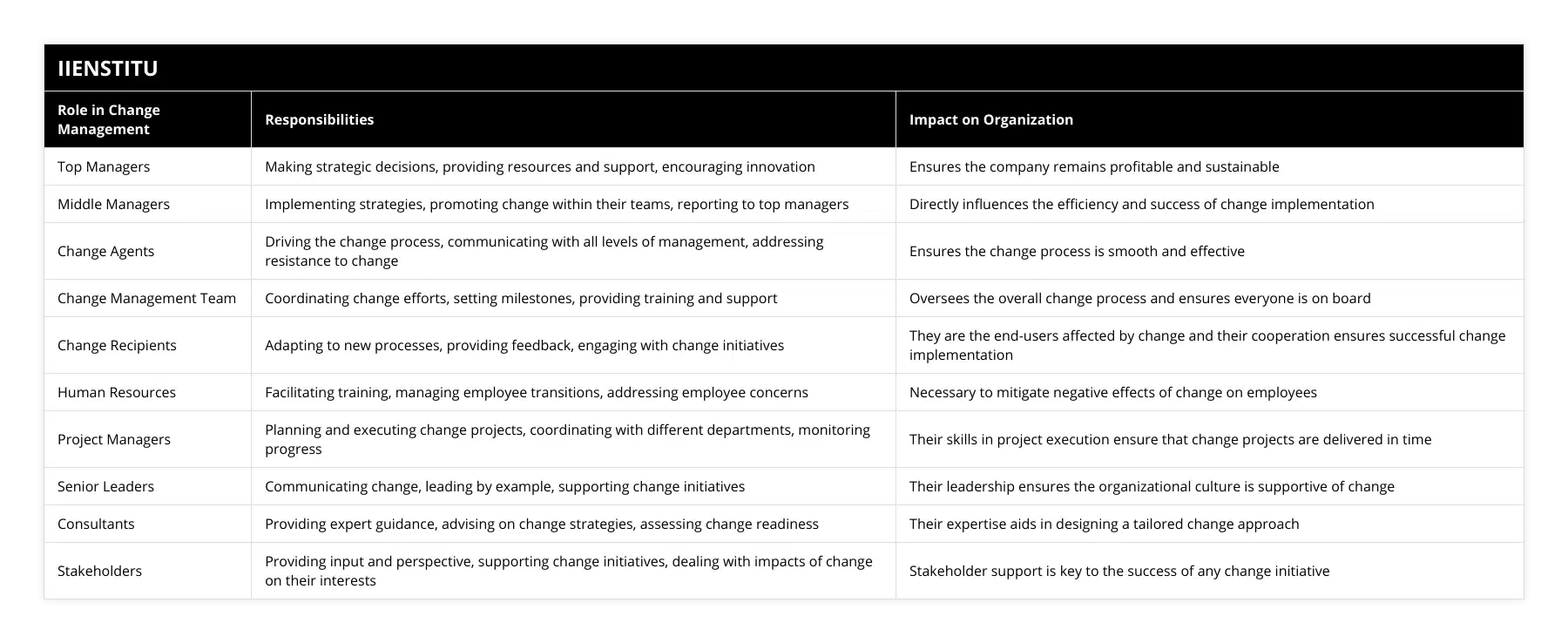
Frequently Asked Questions
When to Use Change Management?
Change management helps manage risks minimizing impacts on people and organization. Because of that change management use for reducing risks.
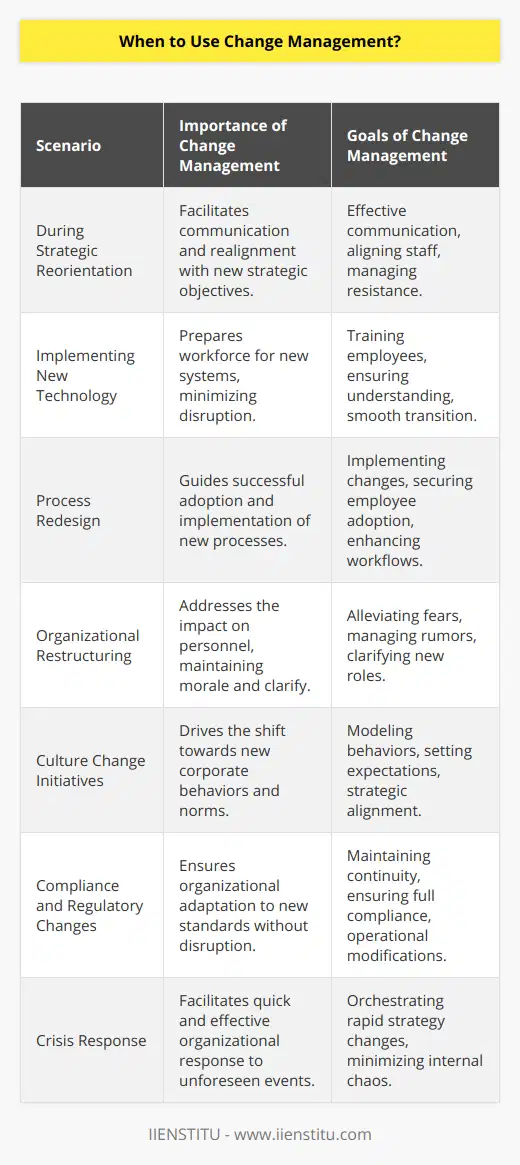
What are the change management stages impact to employees?
There are 4 stages: Denial, anger, bargaining, depression.
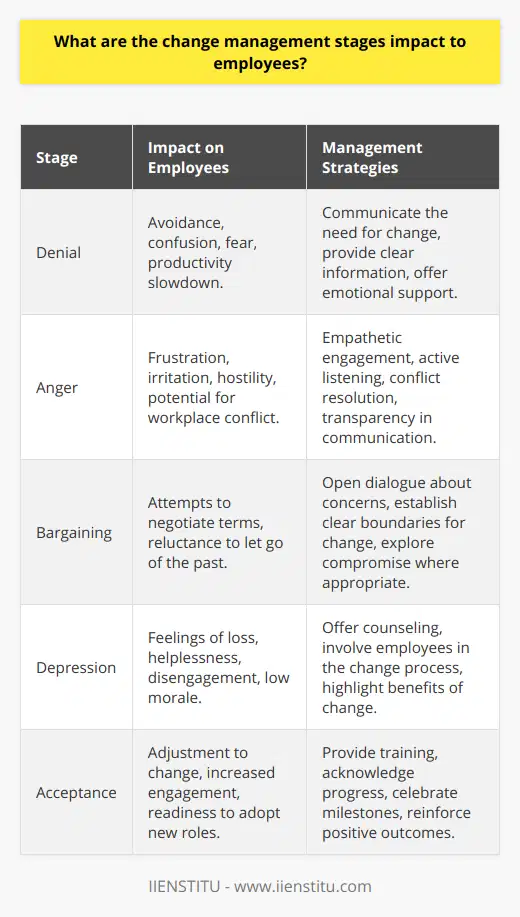
How to manage resistance during change?
Keep at it, ask for help, fight with FOMO, celebrate to success, avoid power struggles.
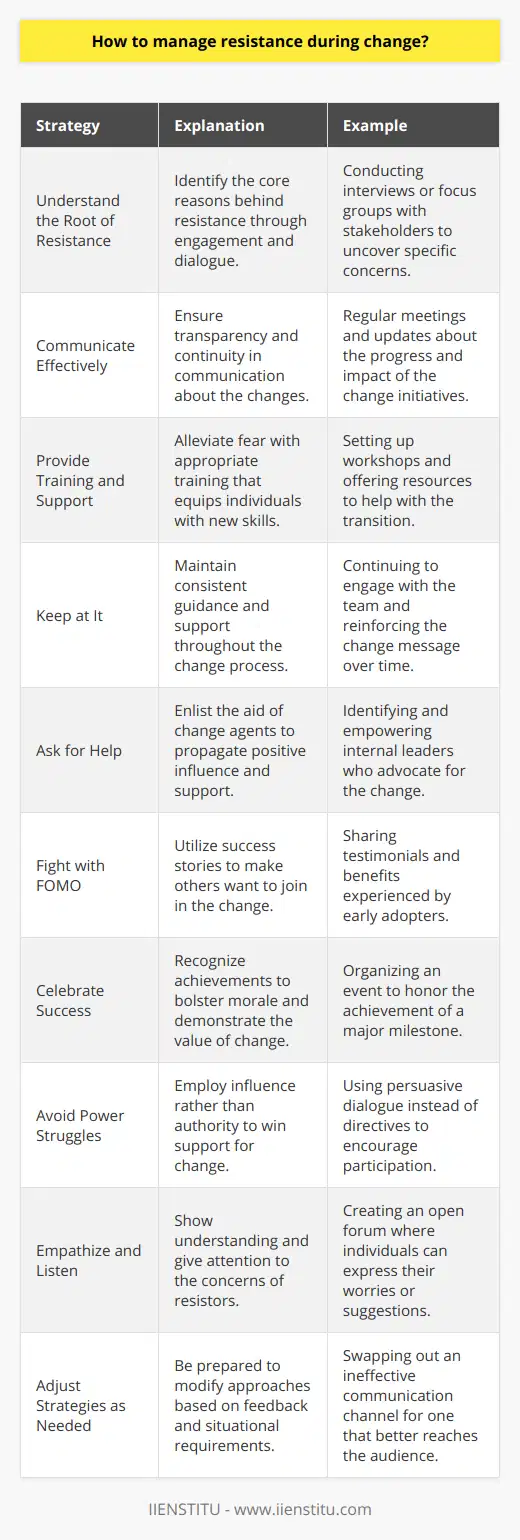
What is the role of leadership in the change management process?
The Role of Leadership in Change Management
Effective Communication
The role of leadership in the change management process is integral, as leaders are responsible for effectively communicating change initiatives to their teams. They must aptly articulate the reasons behind the change, its benefits, and the potential challenges it may present. By doing so, leaders ensure that their team members understand the rationale and become motivated to embrace the change.
Creating a Vision
Leaders must create a clear vision for the change that aligns with the organization's goals and objectives. This involves setting realistic expectations, outlining the necessary steps to achieve the desired outcome, and regularly monitoring progress. By providing a guiding vision, leaders facilitate a sense of collective purpose and direction that encourages team members to work diligently towards achieving the desired change.
Empowering Employees
An essential aspect of leadership in change management is empowering employees to be an integral part of the change process. This involves providing the necessary resources, training, and decision-making autonomy to employees, thus enabling them to contribute meaningfully and take ownership of the outcomes. Empowering employees instills a sense of confidence and trust in the organization's leadership while fostering a positive workplace culture that embraces change.
Managing Resistance
As change is often met with resistance, leaders must be capable of identifying, understanding, and addressing any objections or concerns raised by their team members. This may involve engaging in open and transparent discussions, addressing potential misconceptions and providing necessary support to ease the transition. Through strong leadership, resistance can be overcome, and successful change implementation can be achieved.
Leading by Example
Lastly, leaders play a crucial role in modeling appropriate behaviors and attitudes towards the change, setting the tone for the entire organization. By demonstrating a willingness to adapt and embracing the change themselves, leaders serve as an example for their team members and encourage them to follow suit. This commitment to change helps to create a positive environment that promotes growth and adaptation.
In conclusion, the role of leadership in change management is multifaceted, involving effective communication, creating a guiding vision, empowering employees, managing resistance, and leading by example. By utilizing these strategies, leaders can successfully facilitate and navigate the change process, creating a resilient and adaptive organization prepared to face the challenges of an ever-evolving environment.
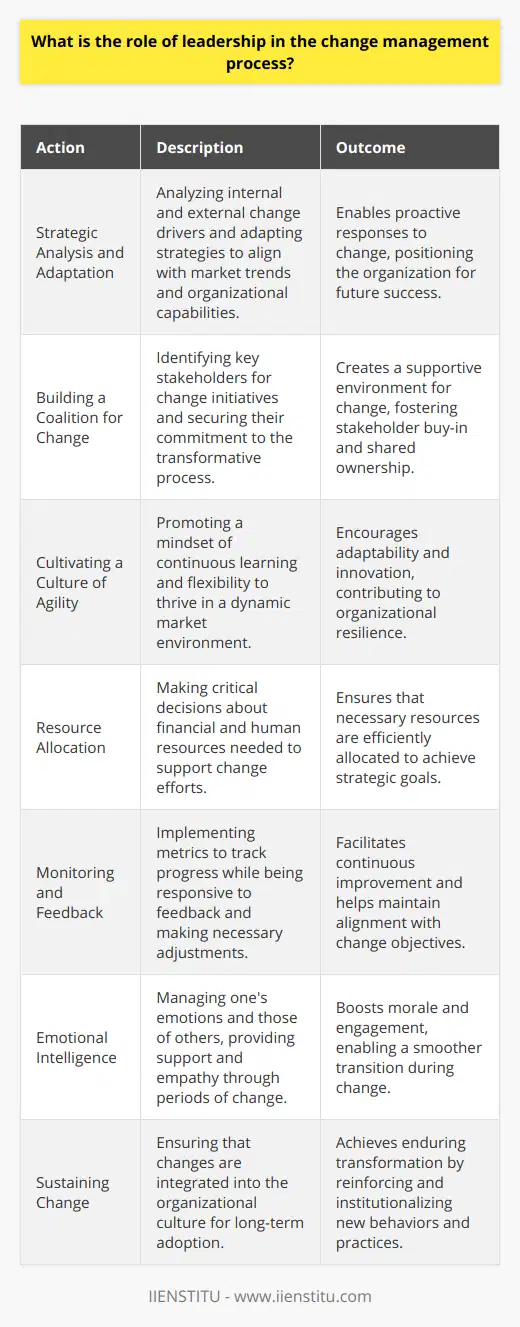
How can communication strategies enhance the effectiveness of change management in an organization?
Role of Communication Strategies in Change Management
Effective communication is crucial to the success of change management initiatives in organizations. By sharing information timely, consistently, and accurately, stakeholders can obtain the necessary information they need to understand and support the change. A well-crafted communication strategy can serve as a roadmap for keeping all parties informed and engaged throughout the transformation process.
Aligning Stakeholders' Perspectives
Aligning the perspectives of various stakeholders is essential for minimizing resistance to change. Communication strategies can be employed to create a shared vision among employees, management, and other stakeholders, thereby fostering collaboration and commitment to change. By clearly explaining the reasoning behind the change and addressing potential concerns, employees will be more likely to embrace the new direction and adapt accordingly.
Managing Expectations and Uncertainty
Effective communication contributes to successful change management by managing expectations and reducing uncertainty. A communication plan can outline the rationale for change, the goals and objectives, and the anticipated impact on employees and stakeholders. This can quell anxieties and misconceptions about the change process, fostering a more positive and confident outlook among the workforce.
Facilitating Employee Participation
Communication strategies can enhance employee participation in the change process, which is crucial to creating a sense of ownership and commitment among employees. By soliciting feedback and ideas from all levels of the organization, management can gain valuable insights and perspectives to refine the change initiative. Involving employees in discussions and decisions related to the change effort can promote buy-in and feelings of empowerment, increasing the likelihood of a successful implementation.
Promoting Transparency and Building Trust
An open and transparent communication approach can build trust among stakeholders and reinforce the importance of honesty and candid dialogue during the change process. When employees feel their concerns and opinions are being heard and considered, they are more likely to believe in the change initiative and trust that management has their best interests in mind.
Measuring Success and Learning from Experience
Finally, effective communication strategies can aid organizations in measuring the success of their change management initiatives. Regular progress updates and sharing of results can provide valuable insights into what is working well and where improvements can be made. Lessons learned from previous change efforts can be leveraged to refine the organization's approach to future change management endeavors.
In conclusion, communication strategies play a vital role in enhancing the effectiveness of change management in organizations. By aligning stakeholder perspectives, managing expectations, facilitating employee participation, promoting transparency, and measuring success, organizations can foster a supportive culture of change and maximize the potential for successful transformations.
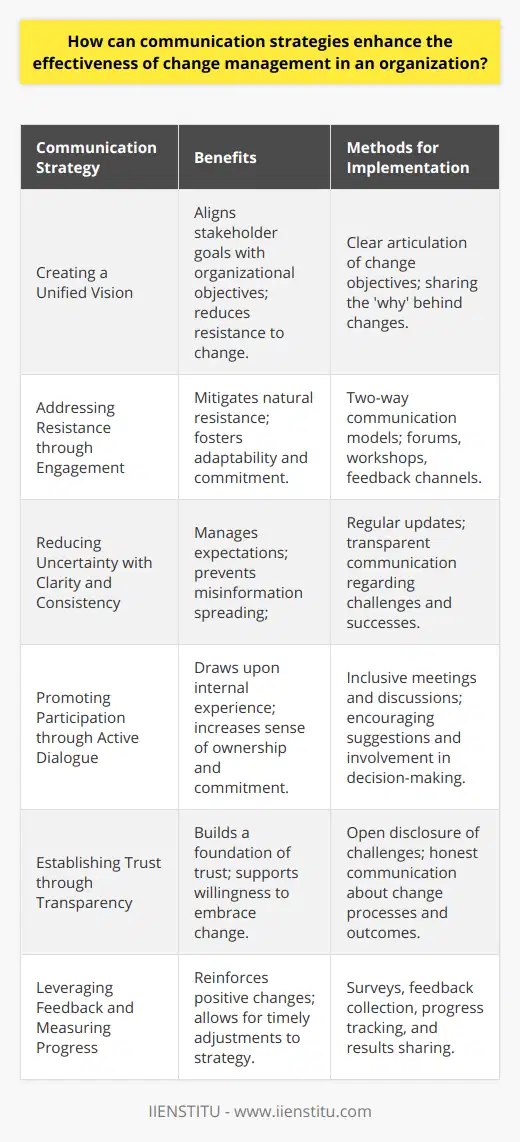
What are the common challenges faced by organizations during the implementation of change management?
Challenges in Change Management
Understanding Employee Resistance
Organizations often face employee resistance during change management implementation, primarily due to fear of the unknown and concerns over job security, leading to a lack of motivation to embrace new processes. By providing transparent communication and addressing these concerns, organizations can mitigate employee resistance.
Managing Communication Barriers
Change management relies heavily on clear and effective communication; however, organizations might struggle to consistently disseminate information to all stakeholders. This communication gap can result in misunderstandings and slow down the change adoption process. Implementing a structured communication plan ensures that all employees understand the rationale for changes and their individual roles in the process.
Building Stakeholder Support
Organizations need to secure support from key stakeholders to successfully implement change management. Without buy-in from these influential groups, initiatives face potential hurdles and may not yield desired results. Engaging stakeholders early in the process and demonstrating the benefits of change management can help build support and reduce opposition.
Maintaining Organizational Culture
Change management initiatives can disrupt the existing organizational culture, which may lead to conflicts within the workforce. Organizations must understand the impact of the changes on their culture and ensure that they align with the overarching company values. By integrating change management into the organizational culture, companies can foster smooth transitions and maintain employee morale.
Addressing Resource Constraints
Limited resources pose a challenge to organizations implementing change management. Financial, human, and time constraints can place pressure on the change management process, limiting its effectiveness. Prioritizing project goals and allocating necessary resources is essential to overcoming these constraints and achieving successful change management outcomes.
Adapting to Unforeseen Circumstances
Organizations must account for unforeseen circumstances during the change management process. Unanticipated events, such as market changes or technological advancements, can impact the success of change management initiatives. Thus, organizations should ensure flexibility in their approach and continuously reassess their strategies to adapt to any unexpected developments.
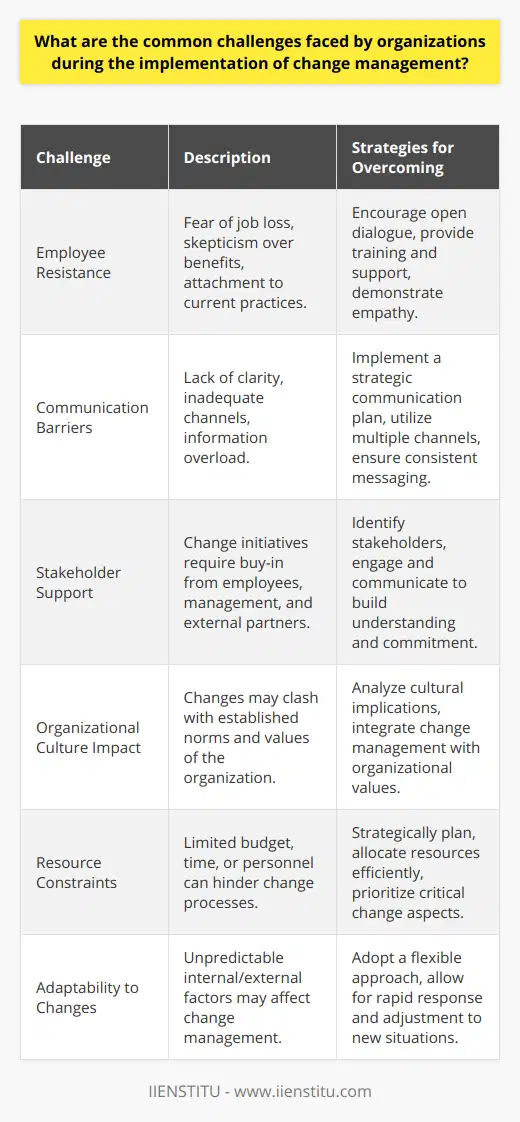
What do you mean by change management?
Understanding Change Management
Change management refers to the systematic approach employed by organizations to handle transitions or modifications in their strategic direction, goals, structure, or processes. This involves preparing, supporting, and adapting staff members to embrace new ways of working, thereby ensuring organizational resilience, innovation, and success. The concept of change management is critical for any organization seeking to foster a culture of adaptability while preserving employee satisfaction, productivity, and overall performance.
Employing Change Management Strategies
Various strategies for change management have been developed over the years, including Kotter's Eight-Step Process, Lewin's Change Management Model, and the ADKAR Model. Each of these models emphasizes different aspects and techniques in guiding organizations through change. However, there are three essential elements that most change management strategies typically address: communication, employee involvement, and continuous improvement.
Effective Communication
The first fundamental principle in managing change is effective communication. Open, honest, and timely communication of both the reasons for the change and the potential impact on staff is crucial for winning their support, addressing concerns, and mitigating resistance. This requires developing appropriate communication plans and channels, ensuring that all messages are consistent, clear, and empathetic to stakeholders' perspectives.
Inclusive Employee Involvement
The second essential component of change management is the involvement of employees at all levels. By involving employees in decision-making, brainstorming, and implementation processes, they are more likely to feel valued, committed, and accountable, leading to a collaborative and positive attitude towards change. Inclusion also provides opportunities for utilizing their individual skills, ideas, and knowledge to create better and more efficient solutions.
Embracing Continuous Improvement
The last critical element in change management is continuous improvement. Organizations should treat change as an ongoing process that requires regular evaluation and adjustment rather than an isolated event. By maintaining an open feedback loop, monitoring progress, and gathering feedback from all stakeholders, organizations will be able to identify unforeseen challenges, make necessary adjustments, and learn from outcomes. This approach fosters a learning mindset, facilitating a more positive attitude towards changes in the organization.
In conclusion, change management is the systematic implementation and management of organizational transitions, enabling organizations to evolve and adapt to meet evolving needs and challenges. By employing effective communication, inclusive employee involvement, and an emphasis on continuous improvement, organizations can build a resilient, innovative, and adaptive culture to thrive in today's fast-paced and competitive world.
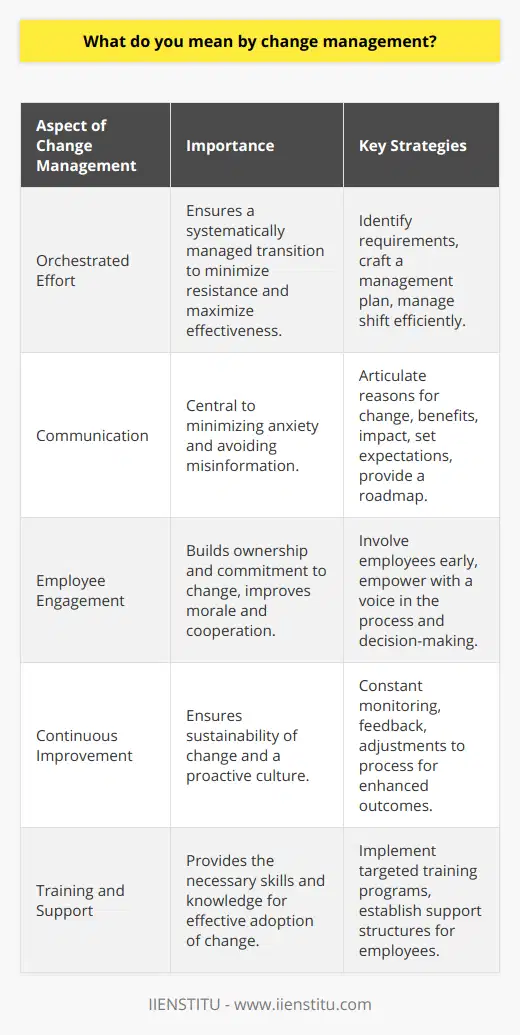
What are the 5 key elements of change management?
Five Core Principles
To ensure the success of change initiatives within an organization, it is crucial to consider the following five key elements of change management.
Vision and Strategy
A clear vision and well-defined strategy are foundational to driving change initiatives. Organizations should establish a compelling change vision, articulate the strategic objectives, and communicate them effectively to all stakeholders. A strong vision and strategy will guide decision-making and align the organization towards achieving its desired outcomes.
Stakeholder Engagement
Actively involving stakeholders in the change process is paramount for the success of change initiatives. Identifying key stakeholders, understanding their needs and concerns, and addressing them effectively will foster buy-in, increase adoption rates, and facilitate a smoother transition. Continuous communication, consultation, and collaboration with stakeholders will ensure alignment and commitment to the change process.
Leadership and Support
Change initiatives require strong leadership and support from top management to drive them forward. Change leaders should model the desired behaviors, champion the change, and provide the necessary resources and support to implement the new processes and systems. They should also create a culture of accountability, transparency, and continuous improvement to reinforce the change efforts.
Skills and Capabilities
Effective change management entails equipping employees with the necessary skills and capabilities to navigate and adapt to the new environment. This involves providing appropriate training, coaching, mentoring, and support to help them acquire new knowledge, skills, and behaviors. Investing in capacity building and skill development will not only facilitate the change process but also enhance the organization's overall competitiveness and resilience.
Measurement and Evaluation
Lastly, measuring and evaluating the progress and outcomes of change initiatives is critical for continuous learning, improvement, and sustaining the change. Organizations should establish clear goals, performance indicators, and evaluation mechanisms to track the success of change efforts. By monitoring performance, identifying areas of improvement, and implementing necessary adjustments, organizations can ensure effective and sustainable change management.
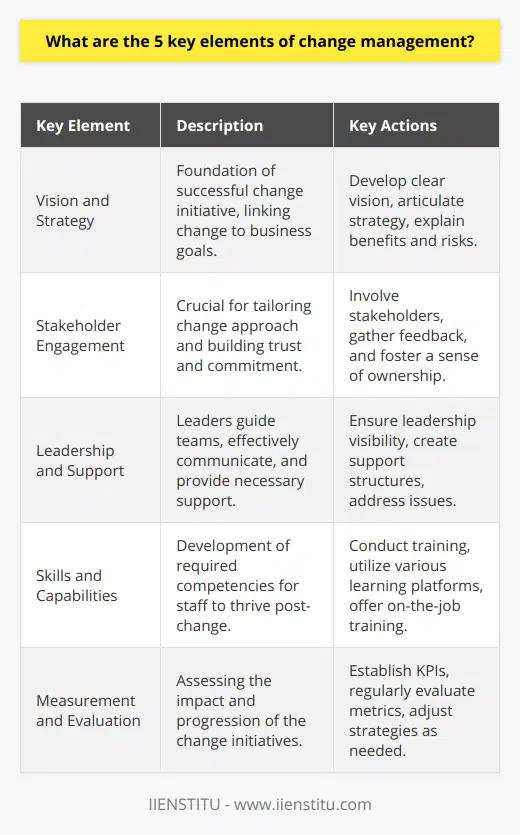
What are the 3 C's of the change management?
Overview of the 3 C's of Change Management
The 3 C's of change management are essential aspects to consider when implementing strategic changes in a business or organizational context. These include Communication, Collaboration, and Commitment, which together play a pivotal role in facilitating organizational transformation.
Effective Communication
Effective communication is a vital element for the success of change initiatives. It entails conveying clear, consistent, and concise information to all stakeholders involved in the change process. This ensures that everyone understands the objectives, the rationale behind the changes, and the associated benefits. Moreover, maintaining open channels of communication facilitates feedback exchange, which can contribute to addressing potential risks, challenges, or misconceptions associated with the change process.
Promoting Collaboration
Collaboration is the foundation of successful change management, as it encourages collective ownership of the change process while fostering positive relationships among team members. Providing opportunities for employees to work together and share knowledge, skills, and experiences can lead to innovative problem-solving and more effective change strategies. Furthermore, promoting a culture of collaboration can diminish resistance to change, as individuals feel more supported and engaged in the process when they collaborate with their peers.
Ensuring Commitment
Commitment is the final cornerstone of successful change management. Gaining and maintaining commitment from employees and other stakeholders requires consistent demonstration of the vision, benefits, and feasibility of the proposed changes. This can be achieved through transparent decision-making, active leadership presence, regular progress updates, and recognition of success stories. Ensuring commitment also involves addressing and overcoming resistance, which can manifest in various forms, such as fear or skepticism. By garnering commitment from employees, change managers are more likely to achieve long-term success in their transformation initiatives.
To conclude, the 3 C's of change management (Communication, Collaboration, and Commitment) play a critical role in driving the success of change initiatives. Emphasizing these areas throughout the change process can help organizations more effectively navigate transformations while garnering support and engagement from all stakeholders involved.

What do you mean by change management?
Understanding Change Management
Change management refers to the systematic approach of dealing with organizational shifts or transitions, aiming for a controlled, structured, and efficient process to minimize disruption and achieve desired outcomes. In the dynamic business environment, organizations must adapt to evolving market demands, technological advancements, and global trends to stay competitive and relevant. Change management encompasses strategic planning, communication, stakeholder engagement, and monitoring to navigate this constant state of flux successfully.
Strategic Planning
A robust change management process begins with developing a clear strategy for facilitating change. This involves identifying the need for change, setting objectives, and formulating an action plan to achieve these goals. By preparing a well-thought-out strategy, organizations can anticipate potential obstacles, allocate resources effectively, and maximize the chances of successful implementation.
Communication and Stakeholder Engagement
Effective communication is the backbone of successful change management. Organizations must convey the rationale, benefits, and expected outcomes of the change to employees and stakeholders. Engaging with stakeholders throughout the process helps gain their buy-in, address concerns, and mitigate resistance to change. Transparent dialogue is crucial for fostering a collaborative culture, facilitating knowledge sharing, and ensuring seamless execution.
Monitoring Change Progress
Continuous monitoring enables organizations to assess the progress and effectiveness of change initiatives, adjusting strategies as needed. By tracking key performance indicators and evaluating the impact on organizational performance, organizations can refine their change management approach, identify opportunities for improvement, and drive continuous growth.
In summary, change management is a vital organizational capability that facilitates smooth transitions, minimizing adverse effects on the workforce and the enterprise. By adopting a strategic approach, promoting open communication, and rigorously monitoring progress, organizations can efficiently manage change, capitalize on opportunities, and stay ahead in the increasingly competitive business landscape.

What are the 5 key elements of change management?
**Understanding Change Management**
Change management is a structured approach for ensuring that changes are thoroughly implemented and that the desired benefits are realized. The five key elements of change management include creating a change vision, developing a change strategy, assessing the change impact, implementing the change initiatives, and continuously improving the change process.
**Creating a Change Vision**
The first element is the creation of a clear and compelling vision for the future state of the organization. This vision serves as a guiding light for all subsequent change efforts, providing a direction and purpose for employees throughout the various stages of the change process.
**Developing a Change Strategy**
The second element is the development of a change strategy that outlines the steps, processes, and timelines for implementing change initiatives. This strategy should be grounded in a realistic assessment of the organization's capacity for change and should address any potential barriers or enablers to successful change implementation.
**Assessing the Change Impact**
The third element involves the identification, analysis, and management of the potential effects of the change on various stakeholders, processes, structural, cultural, and technological aspects of the organization. A comprehensive change impact assessment helps organizations anticipate and adequately prepare for the implications of the change on different aspects of the business.
**Implementing the Change Initiatives**
Change implementation is the fourth key element of change management. This entails executing the various tasks, actions, and plans outlined in the change strategy to actualize the desired future state of the organization. Effective change implementation requires robust communication, strong leadership, and ongoing support for employees throughout the change process.
**Continuously Improving the Change Process**
Finally, organizations must continually monitor, evaluate, and refine their change management efforts to ensure that they are achieving desired outcomes while mitigating any unintended consequences of the change. Continuous improvement enables organizations to learn from the experiences of previous change initiatives and to apply these learnings to future change efforts, ensuring a more effective and efficient approach to managing change.
In conclusion, the five key elements of change management — creating a change vision, developing a change strategy, assessing the change impact, implementing the change initiatives, and continuously improving the change process — provide a comprehensive framework that guides organizations in the successful management and implementation of transformative change efforts. By incorporating these elements into their change management approach, organizations can better position themselves to navigate the complex and often unpredictable process of change, achieving lasting and meaningful improvements in their performance and capabilities.

What are the 3 C's of change management?
The 3 C's of Change Management
**Communication**
The first C in change management is communication. Effective communication is crucial in fostering organizational growth, as it strengthens trust, builds morale and encourages information-sharing among employees. Managers should be transparent about the nature of the change and its purpose, as well as provide employees with a clear understanding of their roles in the transformation process. Regularly disseminating expectations, progress updates, and feedback will enable employees to align their performance with the company's goals.
**Collaboration**
The second C in change management is collaboration, which entails involving all stakeholders in the change process. By fostering a collaborative environment, organizations can harness diverse perspectives and expertise, thus addressing complex challenges with innovative solutions. Managers should establish a reliable support system, where employees' ideas and concerns are valued and incorporated into the planning process. Moreover, promoting teamwork ensures the equal distribution of tasks and accountability, resulting in both individual and collective growth.
**Commitment**
Lastly, commitment is the third C in change management, ensuring the long-term success of any change initiative. Cultivating commitment demands consistent reinforcement of change goals and expectations, along with continuous motivation of employees. Managers have the responsibility of demonstrating steadfast dedication to the change process, by steadfastly adhering to company objectives and exemplifying the desired values and behaviors. Furthermore, the provision of appropriate training, resources, and incentives to employees will not only enhance their competence but also deepen their allegiance to the change process.
In conclusion, the 3 C's of change management – communication, collaboration, and commitment – together form a potent framework for driving transformation in organizations. By effectively applying these principles in practice, leaders can foster an environment where employees willingly embrace and support the change, ultimately paving a smoother path for the organization to achieve its long-term goals.
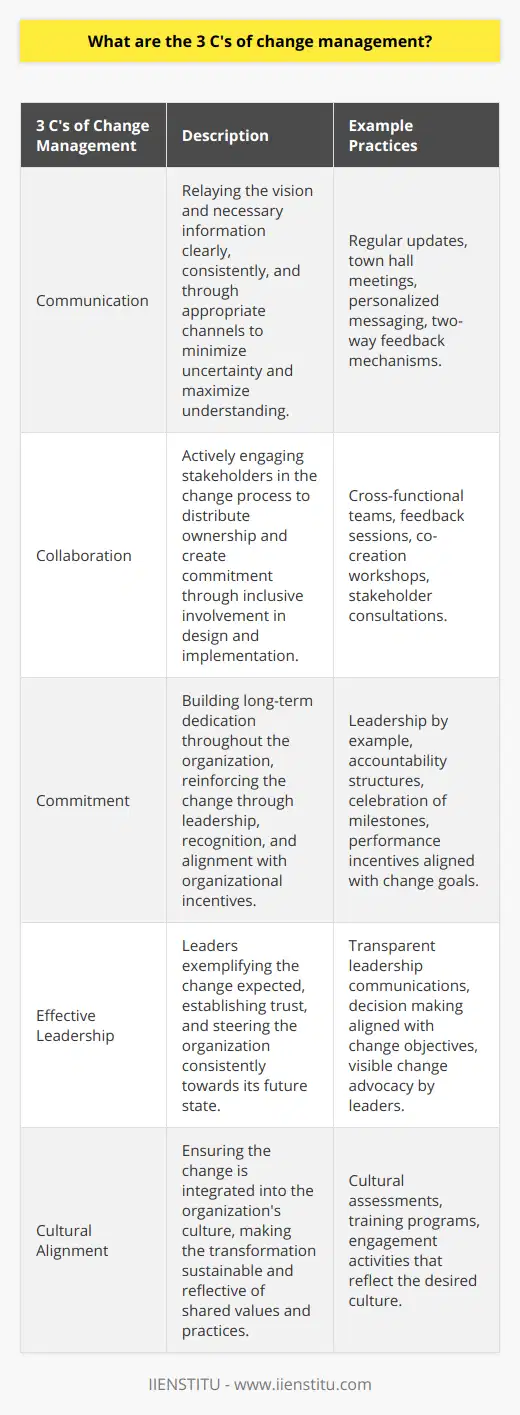
What is the main purpose of change management?
Understanding the Main Purpose
The main purpose of change management is to facilitate the smooth implementation of organizational changes with minimal disruption to employees and operations. This is achieved by thoughtfully planning, communicating, and implementing strategic adjustments in a timely and efficient manner, ultimately ensuring the business's long-term success and sustainability.
Supporting Employees through Change
One critical aspect of change management is its focus on supporting employees as they adapt to new processes, structures, and expectations. Providing training, resources, and guidance can alleviate anxieties, promote a positive attitude towards change, and ultimately improve productivity during the transition phase. By addressing employees' concerns and needs, change management fosters a more resilient and adaptive workforce.
Maintaining Business Continuity
Change management also aims to maintain business continuity throughout the transformation process. By carefully analyzing potential risks, conflicts, and obstacles, change managers can develop strategies to mitigate disruptions and ensure the organization continues to perform at a high level. This includes contingency planning and evaluating the impact of changes on various aspects of daily operations, thereby safeguarding the interests of the organization and its stakeholders.
Realizing Strategic Objectives
Another essential function of change management is ensuring the successful realization of an organization's strategic objectives. Changes are often implemented to achieve specific goals, such as increased efficiency, improved customer satisfaction, or enhanced innovation capabilities. Change management helps organizations align resources, processes, and employees to support the execution of these strategies, thereby maximizing their potential benefits and driving improvements in overall performance.
Measuring Success and Refining Strategies
Lastly, change management involves monitoring and evaluating the effectiveness of the implemented changes. This includes tracking key performance indicators (KPIs), gathering feedback from employees and stakeholders, and assessing the impacts of changes on overall business performance. Based on these insights, change managers can make further adjustments, refine their strategies, and continually enhance the efficacy of change initiatives. This ongoing feedback loop allows organizations to adapt to new challenges and maintain a competitive edge in an ever-evolving business landscape.
In conclusion, change management is a crucial aspect of organizational management that enables businesses to effectively implement transformations, support employee adaptation, maintain business continuity, achieve strategic objectives, and continually refine their change strategies. By efficiently managing change, organizations can enhance their overall performance, maintain a competitive edge, and ensure long-term success.
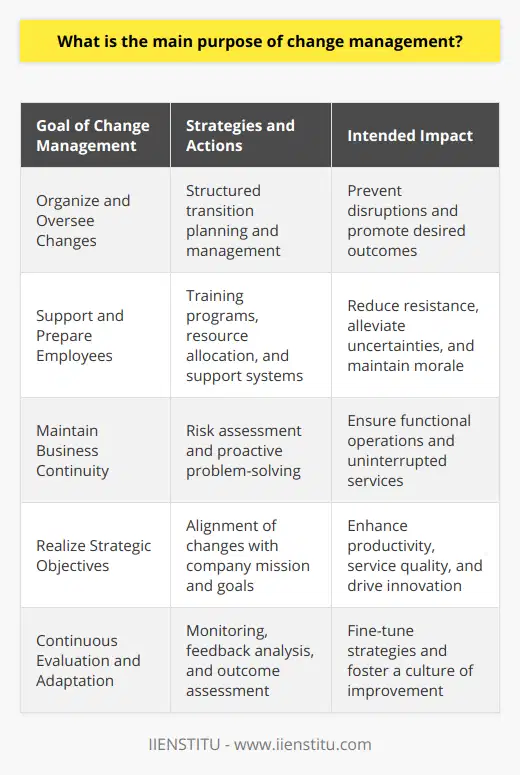
How do change management models differ from one another?
Analyzing Key Components
Change management models are diverse in their approach, structure, and focus, as they cater to unique organizational contexts and objectives involving change. By analyzing the key components of each model, we can appreciate the differences that lie in their perspective, stages or steps, and the role of stakeholders.
A Broader Perspective
The ADKAR model spearheaded by Jeffrey Hiatt concentrates on the individual level, which emphasizes overcoming resistance and transitioning behaviors, while John Kotter's 8-Step Process emphasizes larger-scale strategic organizational changes. The Lewin's Change Management model is another example that takes a broader perspective, by offering a three-step framework that focuses on unfreezing, changing, and refreezing processes for organizational change.
Variations in Stages
The differences in the change management models are also visible in the number of stages or steps involved in the change process. For instance, Kotter's 8-Step Process is elaborate and sequential in nature, starting from creating a sense of urgency and culminating in anchoring new approaches in the organization's culture. In contrast, the McKinsey 7S model presents a non-linear approach, focusing on aligning seven interconnected elements (e.g. strategy, structure, systems, skills, staff, style, and shared values) within the organization.
Diverse Stakeholder Roles
Lastly, the role and prominence of stakeholders vary across different change management models. The ADKAR model specifically highlights the roles of the organization, managers, and employees as change agents. In Kotter's approach, emphasis is placed on the role of a guiding coalition comprising influential individuals who act as change leaders. The Lewin's Change Management model focuses on the organization as a whole through a more systemic approach to change.
In conclusion, change management models differ from one another in terms of perspective, stages or steps, and the role of stakeholders. Each model is designed to address specific aspects of organizational change and is tailored to suit varied change scenarios. By understanding these differences, organizations can choose the most appropriate model to guide their change initiatives, enhance organizational performance, and drive sustainable results.
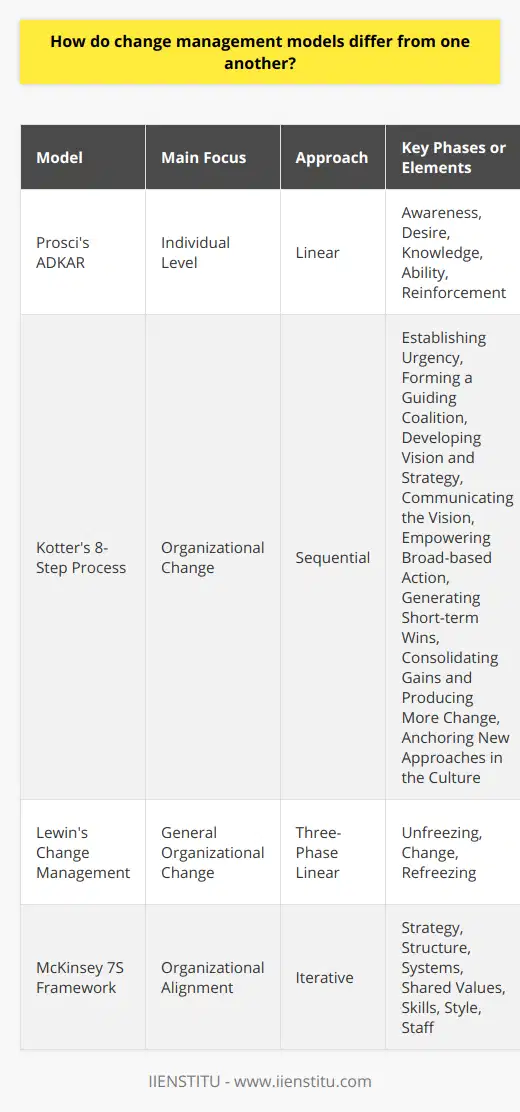
What factors contribute to the success or failure of a change management initiative?
**Factors Influencing Change Management Success**
Change management initiatives often determine the competitiveness and performance of an organization. The success or failure of these initiatives largely depends on several factors, including leadership, employee engagement, communication, and organization culture.
**Leadership and Change Management**
A crucial determinant of change management initiatives' success is the presence of strong leadership. Organizational leaders should possess the ability to articulate the vision, set clear direction, and motivate employees to embrace change. They should also inspire trust and confidence, effectively manage resistance, and provide necessary resources for successful implementation.
**Employee Engagement during Change**
Employee engagement is critical to the success of change management initiatives. Employees who feel valued and engaged in the process are more likely to accept change willingly and contribute positively towards its implementation. Ensuring employees understand the rationale behind the change, addressing their concerns, and providing opportunities for involvement can significantly boost engagement levels.
**Effective Communication in Change Management**
Clear and concise communication plays a pivotal role in successful change management. Organizations need to develop a comprehensive communication plan to ensure that all stakeholders receive accurate and timely information about the change. This helps to minimize confusion, reduce resistance, and foster a sense of ownership among employees. Regular feedback and updates also contribute to the effectiveness of communication in change management.
**Organizational Culture and Adaptability**
Organizational culture often exerts a powerful influence on the success of change management initiatives. A culture that values adaptability to change, continuous learning, and innovation can facilitate a smoother implementation process. On the other hand, a culture resistant to change can hinder the progress and lead to the failure of the initiative.
In conclusion, the success of change management initiatives depends on a combination of factors such as strong leadership, employee engagement, effective communication, and a conducive organizational culture. Addressing these factors can significantly enhance the likelihood of successful change implementation and drive organizational performance.

What are the 7 R's of change management?
The 7 R's of Change Management
Understanding the Principles
The 7 R's of change management represent a practical and methodical approach to effectively facilitate changes within an organization. These seven principles, embedded within the decision-making and implementation processes, help an organization to minimize risk, reduce resistance, and maximize the benefits of proposed changes.
Reason
The first principle focuses on identifying the underlying reason for the proposed change. It involves defining the issue or opportunity that necessitates the modification, ensuring that the change aligns with the overall objectives and goals of the organization.
Risks
Examining potential risks is an essential aspect of change management. This step requires a comprehensive assessment of potential challenges, obstacles, and adverse impacts associated with the proposed change. By identifying risks, organizations can develop plans to proactively mitigate or manage them.
Resources
Effective change management necessitates the allocation of adequate resources. This principle recognizes that changes may require additional personnel, funding, time, or other resources to be successfully implemented and sustained.
Responsibilities
Clearly defining roles and responsibilities is crucial during change management. This ensures that individuals and teams are aware of their specific tasks and duties, facilitating a higher level of accountability throughout the process.
Readiness
The readiness principle involves assessing the organization's overall preparedness to undertake the proposed change. This step may include evaluating existing structures, processes, culture, or employee capabilities, and determining necessary modifications or capacity building initiatives.
Resistance
Anticipating, identifying, and addressing resistance is critical in change management. Resistance can manifest in various forms, including reluctance to change, fear of the unknown, or conflicting interests. Identifying and proactively addressing resistance can support a smoother transition and higher levels of acceptance.
Results
Lastly, the measure of successful change management lies in achieving desired results. This principle focuses on tracking progress, measuring the effectiveness of the change against predefined goals or benchmarks, and adjusting the approach as necessary to ensure a successful outcome.
In summary, the 7 R's of change management - reason, risks, resources, responsibilities, readiness, resistance, and results - provide organizations with a systematic framework to effectively navigate and manage change. Following these principles allows organizations to minimize disruption, enhance adaptability, and ultimately achieve successful transformation.
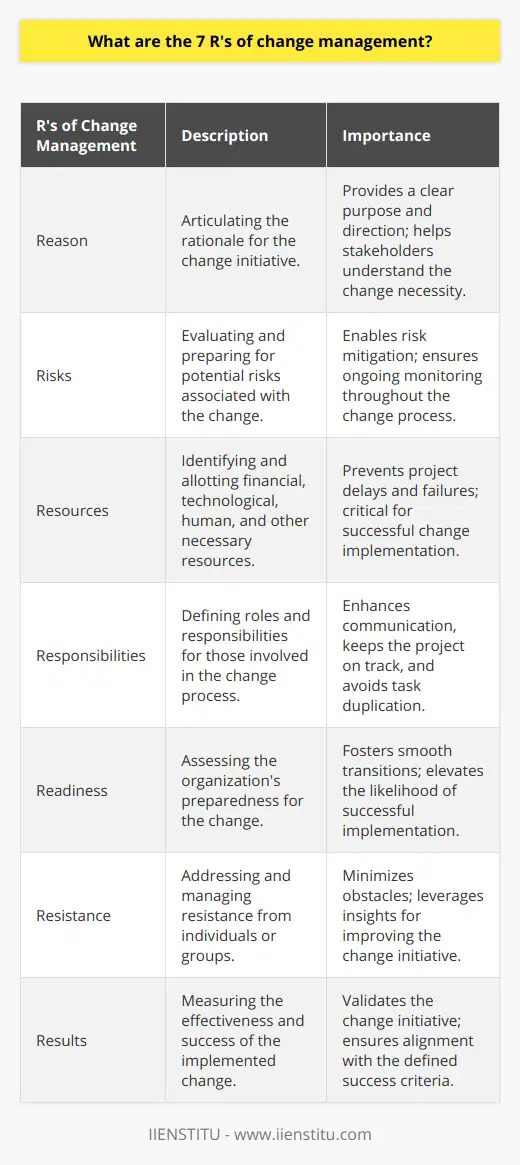
How do organizational culture and change management influence each other?
Organizational Culture and Change Management Interaction
Organizational culture plays a pivotal role in determining the success of change management initiatives. It is crucial because it influences employees' acceptance or resistance to change by shaping their attitudes, behaviors, and beliefs. Furthermore, an organization's culture can either facilitate or hinder change management processes by affecting communication, decision-making, and employee engagement.
Impact of Organizational Culture on Change Management
There are three primary ways organizational culture impacts change management. Firstly, it determines the extent to which employees are open to new ideas and willing to embrace change. A supportive and adaptable culture encourages an organization's workforce to accept and adopt new strategies and approaches. Conversely, a rigid and conservative culture often leads to employee resistance to change, making it difficult to implement new practices.
Secondly, organizational culture affects the level of communication and collaboration within a company. Open channels of communication foster transparency and trust, contributing to smoother change management initiatives. Similarly, a collaborative culture enables employees to work together to navigate change, leading to faster adoption and more efficient execution. In contrast, a culture that values secrecy or compartmentalization hampers change management efforts by impeding information flow and limiting collective problem-solving.
Thirdly, organizational culture influences the decision-making process, which affects change management strategies. A culture that values innovation and calculated risk-taking often leads to effective change management approaches that embrace new technologies and solutions. In contrast, a culture that fears or resists change may result in change management initiatives that focus on maintaining the status quo rather than fostering growth or adaptation.
Role of Change Management in Shaping Organizational Culture
Besides organizational culture impacting change management, effective change management practices can also shape and transform the cultural landscape of an organization. By implementing appropriate strategies, organizations can cultivate a culture that supports change and continuous improvement.
A critical aspect of successful change management involves engaging employees in the process of identifying, planning, and executing change initiatives. When employees are actively involved in change management, they are more likely to embrace and adopt new practices, leading to the development of a culture that is resilient and adaptable to change.
In addition, change management initiatives should focus on fostering a learning culture that encourages employees to continuously develop their skills and knowledge. A culture that values learning and development not only drives improved performance but also prepares the organization for future disruptions and challenges.
Lastly, change management efforts should aim to create a culture that prioritizes open communication and collaboration. A workplace that cultivates trust and transparency fosters a sense of belonging and commitment among employees, enabling them to navigate change with confidence and support each other during periods of uncertainty.
In conclusion, organizational culture and change management are intricately linked, with each influencing the other. A supportive and adaptive culture is essential for the successful implementation of change initiatives, while effective change management practices can transform an organization's culture to become more resilient and open to change.
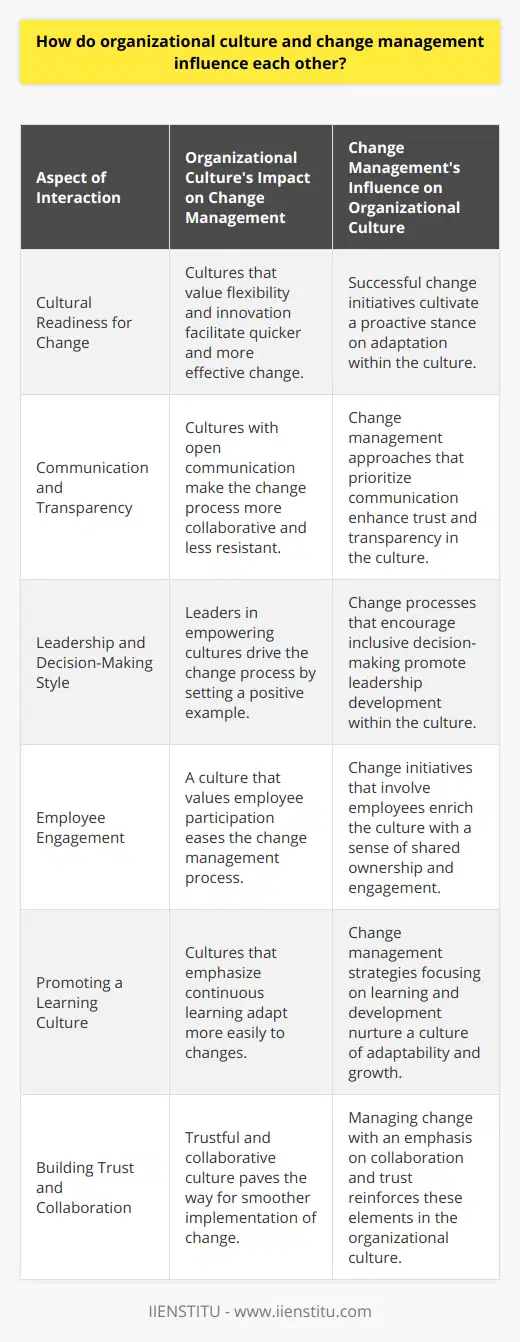
What is the significance of stakeholder engagement in the change management process?
Role of Stakeholder Engagement
The significance of stakeholder engagement in the change management process lies in its ability to foster collaboration, transparency, and trust among all parties involved, thus contributing to the success of change implementation projects. Active engagement facilitates open communication, enabling stakeholders to express their concerns, opinions, and suggestions, which can identify potential issues and enhance solutions.
Building Trust and Relationships
When stakeholders are engaged consistently and genuinely, they are more likely to trust the process and feel a sense of ownership for the changes being implemented. Building strong relationships with stakeholders promotes a shared understanding of the change objectives and enables productive decision-making based on their insights and expertise. This approach helps alleviate resistance and fosters cooperation, as stakeholders are more inclined to support changes that they have participated in shaping.
Enhanced Decision-making Process
Stakeholder engagement enriches the decision-making process through diverse perspectives, leading to more comprehensive and effective change strategies. By incorporating the opinions and experiences of relevant individuals and groups, decision-makers can consider multiple aspects of the organizational environment, ensuring alignment with organizational goals and values. This inclusivity enhances the overall design and execution of change initiatives, ultimately increasing the likelihood of achieving successful outcomes.
Risk Mitigation and Opportunity Identification
Proactively engaging stakeholders in the change management process also facilitates risk mitigation and the identification of new opportunities. By gathering insights from various sources, organizations can anticipate potential challenges and take early measures to address them. Furthermore, stakeholder input can reveal hidden opportunities, helping to maximize the benefits derived from change initiatives.
Strengthening Change Resilience and Adaptability
As the pace of change accelerates in the business world, organizations must develop resilience and adaptability to remain competitive. Stakeholder engagement fosters a culture of change readiness among all members, promoting shared responsibility and involvement in ongoing improvements. This collective mindset enhances an organization's ability to navigate and respond to emerging trends and disruptions effectively.
In conclusion, stakeholder engagement plays a critical role in the change management process, fostering strong relationships, informed decision-making, risk mitigation, and heightened resilience. By actively involving stakeholders in driving change initiatives, organizations are better positioned to achieve long-term success and maintain competitive advantage in an increasingly complex and dynamic business environment.
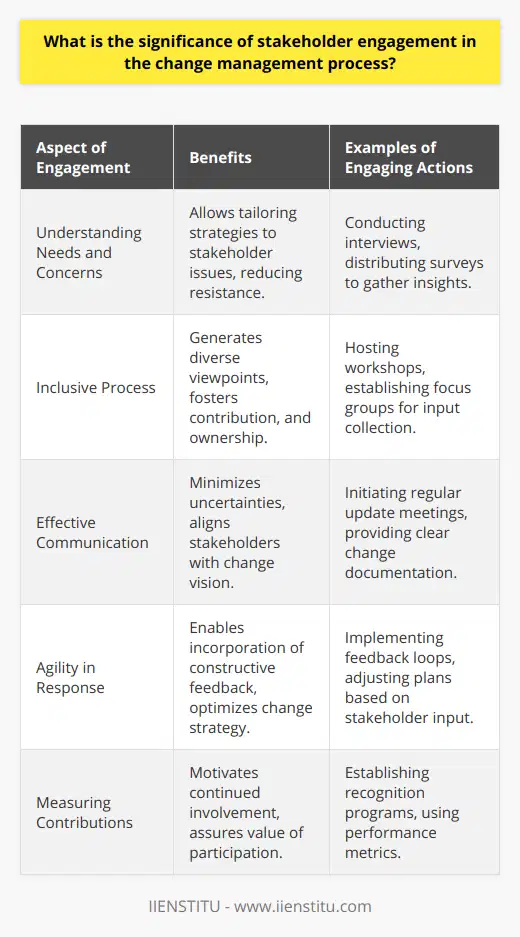
What is the definition of change management in the workplace?
Defining Change Management in the Workplace
In the modern workplace, change management refers to the systematic approach for aiding organizations to transition from their current state to a desired future state. Change management aims to ensure the implementation of new methods or systems with minimal disruptions, employee confusion, or resistance, thus maximizing their effectiveness and benefits. The complexity, scale, and impact of changes can vary from minor procedural adjustments to large-scale organizational overhauls. Regardless of the scope, effective change management is vital for maintaining and enhancing workplace productivity and performance.
Key Components of Change Management
Leadership and Vision: The development and communication of a guiding vision by organizational leaders serve as the foundation for directing and motivating employees through the process of change.
Engaging Employees: Involving employees in the planning and implementation stages of change management is essential to foster their buy-in and commitment, thereby facilitating smoother transitions and minimizing resistance.
Training and Support: Providing adequate training and ongoing support for employees during the change process ensures they develop the necessary skills and knowledge to adopt, implement, and adapt to the new changes.
Communication: Maintaining transparent and open lines of communication during the change process helps address employee concerns, clarify expectations, and minimize misconceptions or rumors.
Monitoring and Evaluation: Systematic monitoring and evaluation of the change management process enables organizations to refine strategies, identify issues, measure progress, and assess the impact of change on various aspects of the workplace.
In summary, change management in the workplace is a strategic process designed to facilitate the adoption and implementation of new systems or practices. By involving employees, providing training and support, and maintaining open communication, organizations can navigate change more effectively, ultimately driving workplace performance and productivity.

How does change management contribute to organizational effectiveness and resilience?
Change Management's Role in Organizational Effectiveness
Change management is a critical component in enhancing organizational effectiveness. It involves the structured processes, tools, and methods for managing the people-side of change, aimed at achieving organizational goals and objectives. Adapting to change is essential for organizational resilience, as it enables businesses to respond proactively to the dynamic nature of the market.
Creating a Culture of Adaptability
One way change management contributes to organizational effectiveness is by fostering a culture of adaptability. This culture provides a solid foundation for embracing new strategies, technologies, and processes. Employees develop skills that enable them to accept and adapt to change, minimizing resistance and enhancing overall performance.
Efficiency through Process Improvement
Change management also improves organizational efficiency by promoting process improvement. Through this approach, organizations continuously evaluate and modify their operations to optimize performance. Enhancements in processes create cost savings, reduces waste, and ensures the alignment of the organization with its strategic objectives.
Innovation and Competitive Advantage
By being open to change, organizations develop their innovative capabilities, leading to a competitive advantage in the market. Organizations that can identify and implement new ideas, products, or services in response to external challenges are more likely to succeed. Change management enables businesses to quickly adapt to novel challenges by refocusing their resources and capabilities accordingly.
Promoting Employee Engagement
Through change management strategies, organizations can successfully engage their employees, leading to heightened motivation and commitment. Communication and training play a vital role in ensuring employees understand their new roles and responsibilities. Employee involvement in the decision-making process can also lead to higher levels of satisfaction, thus increasing overall performance and productivity.
Managing Risk and Uncertainty
Lastly, change management aids organizations in managing risk and uncertainty. By anticipating the impacts of change, businesses can adequately prepare for potential disruptions and challenges. Monitoring and evaluating the effectiveness of implemented changes ensures that organizations can modify their strategies to overcome any obstacles they may encounter.
In conclusion, change management is a crucial component in building organizational effectiveness and resilience. By fostering an adaptable culture, improving processes, driving innovation, engaging employees, and managing risks, change management enables organizations to navigate the complexities of today’s business landscape.
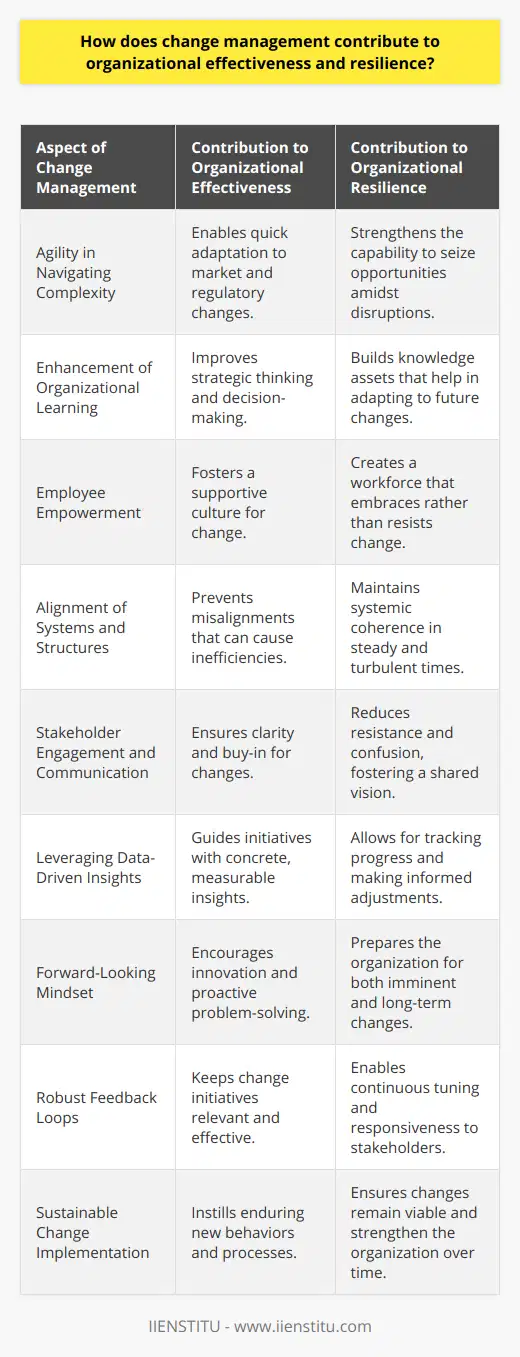
Can you provide an overview of the key principles and methodologies utilized in change management?
Key Principles in Change Management
Firstly, a core principle of change management involves establishing a clear vision and communicating it effectively to stakeholders. This ensures that everyone understands the objectives and benefits of the change, as well as their role in achieving them. Secondly, effective change management requires strong leadership that is dedicated to guiding and supporting individuals through the transition. Leaders must be adaptable, empathetic, and skilled in resolving conflicts to minimize resistance and facilitate change adoption.
The importance of stakeholder involvement
Another principle is the active involvement and participation of stakeholders – including employees, suppliers, and customers – in the change process. This can be achieved through consistent communication, soliciting feedback, and creating an environment that encourages open dialogue. Involving stakeholders not only increases their commitment to the change but also provides valuable insights that can improve the change process.
Managing change through methodologies
Change management methodologies serve as structured approaches to plan, execute, and monitor the effectiveness of changes in an organization. A few widely-used methodologies include Lewin's Change Management Model, Kotter's 8-Step Process, and the Prosci ADKAR Model.
Lewin's Change Model: Unfreeze-Change-Refreeze
This model emphasizes three stages in the change process. The 'unfreeze' stage involves creating awareness and preparing the organization for change. The 'change' stage comprises implementing the planned changes and supporting the transition. Finally, the 'refreeze' stage solidifies the change, ensuring it becomes a permanent part of the organization's culture.
Kotter's 8-Step Process for Change
Kotter's process involves eight sequential steps: creating a sense of urgency, forming a powerful coalition, creating a vision, communicating the vision, removing obstacles, creating short-term wins, building on the momentum, and embedding the change into the organization's culture. These steps focus on addressing common challenges faced during change management, such as overcoming resistance and maintaining momentum.
Prosci ADKAR Model: Awareness-Desire-Knowledge-Ability-Reinforcement
The ADKAR model presents a series of sequential, outcome-oriented goals that individuals must achieve for successful change adoption. The five components – awareness, desire, knowledge, ability, and reinforcement – help change managers understand and address the needs, motivations, and potential obstacles faced by individuals during the change process.
Conclusion
Effective change management involves a combination of key principles and structured methodologies that address the needs of both the organization and its individuals. By recognizing the importance of clear communication, strong leadership, stakeholder involvement, and using suitable methodologies, organizations can optimize their change management process and successfully navigate transformations.

What do you mean by change management?
Change Management Overview
Change management is a structured approach to shifting individuals, teams, or organizations from a current state to a desired future state. It seeks to lower resistance to change, enabling a transition to take place smoothly.
Understanding the Concept
In essence, change management is about managing the people side of change. It includes processes, tools, and techniques to manage the people side of change to achieve the required business outcome. It's a discipline aiming for simplicity despite inherent complications.
Key Elements of Change Management
Change management revolves around three key elements. Firstly, the 'change' itself which can take many forms, such as a new business process, or changes in organization structure or job roles. Secondly, the 'transition' or 'transformation', which is the internal process people go through to come to terms with the change. Lastly, the 'managing' aspect, which involves guiding and supporting people through this process of change.
Role of Change Management
Change management plays an integral role in increasing project success and returns on investment. By understanding, planning, and implementing change, organizations mitigate risk, ensure employee engagement, and maintain business operations. Therefore, organizations need effective change management to remain competitive.
Conclusion
In sum, change management is a systematic approach used by businesses to transition people and processes for positive growth. It's an essential strategy in today's fast-paced business environment to ensure an organization adapts, survives, and thrives in light of continuous changes.

What are the 5 key elements of change management?
Change Management: Key Elements
Clear Vision
A clear vision is a vital element in change management. The organization should articulate the reasons for the change and how it aligns with the organization's overall goals.
Leadership Commitment
Effective change management requires committed leadership. Decision-makers must invest time and resources, communicate consistently, and champion the change throughout the organization.
Stakeholder Engagement
Engaging all stakeholders is a critical aspect of change management. This involves ensuring their understanding, involvement, and ultimately, their commitment to the change.
Effective Communication
Concise, clear, and consistent communication is a foundational element for managing change. It assists people in understanding the rationale behind the change, making the transition smoother.
Training and Support
Lastly, adequate training and support for employees undergoing the change process is paramount. This allows the workforce to acquire necessary skills and reduces resistance as they transition.
In conclusion, change management involves a multifaceted approach, and its success is contingent on these five key elements.

What are the 3 C's of change management?
Change Management Fundamentals
The concept of '3 C's' plays a pivotal role in change management. These are: Communication, Collaboration, and Commitment.
Communication in Change
In change management, communication is integral. It involves delivering the objective of the change, its necessity, and its potential impact. Effective communication minimizes resistance by dispelling fears and misconceptions, which can obstruct the adoption of the impending change.
Building Collaboration
Secondly, collaboration forms an important pillar of change management. Collaboration necessitates rallying all stakeholders towards a shared understanding and a unified approach to implementing said change. This aspect of change management promotes collective support and shared responsibility, mitigating the risk of change rejection or resistance.
Cultivating Commitment
Finally, commitment is where all stakeholders actively support and propagate the proposed change. It involves pursuit of the change with diligence and patience. It's essential for maintaining momentum throughout the change process and ensuring successful implementation. The higher the level of commitment, the smoother the change process tends to be.
In summary, successful change management relies on robust communication strategies to articulate the change vision, fostering a collaborative environment and cultivating steadfast commitment among all stakeholders to realize the proposed change. The '3 C's' of change management - Communication, Collaboration, and Commitment - thus form the crux of any change management initiative.

What are the 4 C's of change management?
Change Management: The 4 C's
Change Management involves the application of systematic methods to deal with change, both from the viewpoint of an organization and on the individual level. One of the key frameworks used to approach this is the 4 C’s of Change Management: Communication, Collaboration, Commitment, and Culture.
Communication
Communication plays an instrumental role in managing change. A well-structured communication plan allows the organization to share the reasons for the change, its benefits, and how it will affect the stakeholders. Clarity in conveying these key messages reduce resistance and promotes understanding.
Collaboration
Collaboration is crucial for successful change. By including all stakeholders in the change process, it creates a sense of ownership. Moreover, it fosters an environment that encourages diverse views, improves decision-making, and supports successful change implementation.
Commitment
Commitment underscores the importance of stakeholders’ buy-in. Leaders must show dedication to the process of change. Not only must they support the change, but they must also model it, as their conviction demonstrates its importance and influences others to commit.
Culture
Culture is the final component of the 4 C’s. Change must align with the organization's culture to prevent friction. Understanding the organization’s values, beliefs, and behaviours helps in designing strategies that dovetail with its culture, promoting a smoother change process.
In conclusion, the 4 C's of Change Management: Communication, Collaboration, Commitment, and Culture, provide a valuable scaffold to approach and navigate change. By centering proceedings around these four pillars, organizations enhance their likelihood of successful change implementation.
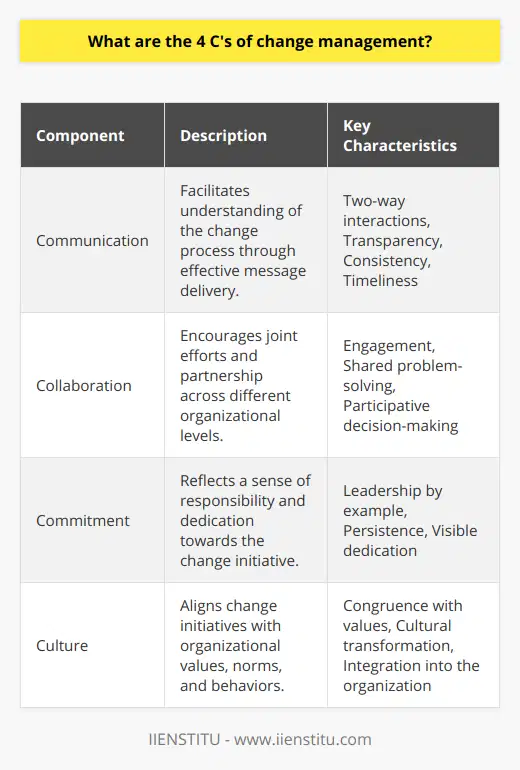
What are the 5 W's of change management?
Understanding the five W's of Change Management
Who
The first W stands for 'who,' referring to the individuals or groups involved in the change process. It identifies those who will effect the change and those who will be affected by it. Leadership must manage both groups, ensuring full engagement and understanding of the process.
What
The second W refers to 'what,' which addresses the actual change or transformation taking place. This might involve new business processes, organizational structures, or shifts in corporate culture. It's crucial to make clear what the expected outcomes of these changes are.
Why
The 'why' is the rationale or the reason for the change. This can include competitive pressures, advancements in technology, strategic growth opportunities, or process improvement initiatives. Being clear about why the change is necessary helps gain support from employees and other stakeholders.
When
The 'when' is the timeline of the change, laying out key milestones and deadlines. Change management requires careful planning and pacing to ensure minimal disruptions to business operations. It also needs clear communication of the timeline to all those involved.
Where
Lastly, the 'where' refers to the geographical location or business units where the change will take place. This could be a single department, across multiple offices, or even on a global scale. Understanding 'where' the change occurs can better manage impact and ensure successful implementation from one location to another.
In conclusion, the five W's of change management - who, what, why, when, where - offer a structured approach to navigate and manage transformation within an organization effectively. Understanding and applying these principles can help ensure a smooth, efficient, and sustainable change process.
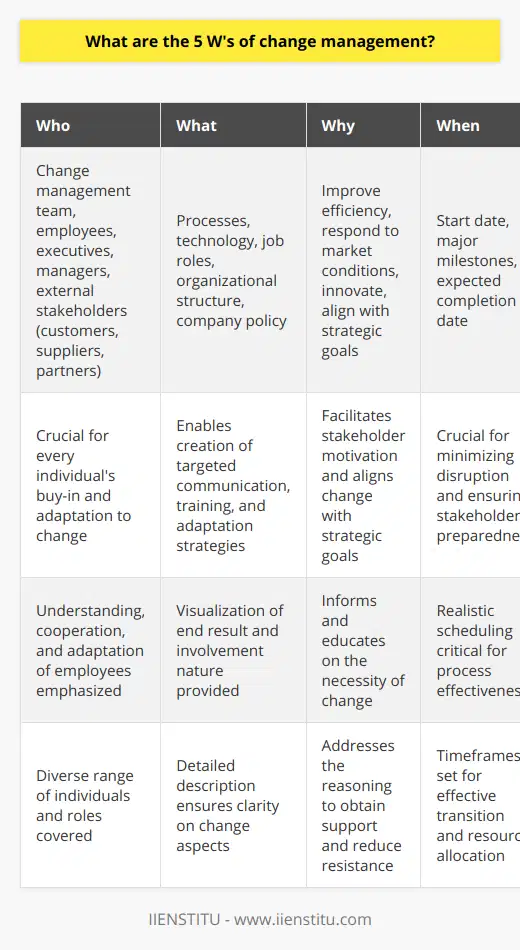
How do change management theories and practices address the human aspect of organizational change?
Human Emphasis in Change Management Theories
Change management theories often place a strong emphasis on the 'human factor' because they understand the pivotal role employees play in any organizational transformation. Various strategies exist to address this human aspect.
Involvement and Engagement
One notable theory is Lewin’s three-step model, which recommends 'unfreezing' current behaviors, introducing new behaviors, and then 'refreezing' them. This theory emphasizes the fact that employees, not just structures and processes, need to change. Active involvement of both management and employees is key.
Performance and Adaptability
Also, the ADKAR model underlines employees’ roles in accepting and adapting to change, focusing on their awareness, desire, knowledge, ability, and reinforcement. This model underscores that every individual’s performance during an organizational change can largely influence its outcome.
Psychological Perspectives
There's also Bridges' transition model that delves into the psychological aspects. It sheds light on the emotional processes often experienced during a transformative phase, such as end, neutral and new beginning phases. Understanding employees' psychological states can greatly assist in implementing successful change.
Sensitivity to Local Cultures
Furthermore, some theories stress that global companies must be culturally intelligent. That means respecting, adapting to, and incorporating aspects of different cultures when initiating changes, to ensure employee acceptance and buy-in.
Managing Resistance
Consequently, managing resistance is another crucial factor. Effective change management theories propose varying strategies to identify, understand and reduce resistance, from demonstrating empathy, providing adequate information and support, to promoting active participation.
In conclusion, change management theories and practices do not sideline the human component of organizational transition. Instead, they place it at the heart of change, recognizing that successful transformation largely hinges on the emotional, psychological, and physical acceptance of change by the employees.
